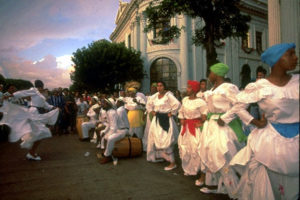 The "plena" and "bomba" are still thriving in Puerto Rico. Like the Calypso from Trinidad, the "plena" is characterized by its simplicity and repetition, like all folkloric music, it is spontaneous expression of everyday occurrences. In Puerto Rico, it was influenced by people with African heritage. Themes included religion, local and national events, recipes, advice, and superstition. The philosophical element is also present. In other words, it embellishes themes that lure the imagination of the people.
The "plena" and "bomba" are still thriving in Puerto Rico. Like the Calypso from Trinidad, the "plena" is characterized by its simplicity and repetition, like all folkloric music, it is spontaneous expression of everyday occurrences. In Puerto Rico, it was influenced by people with African heritage. Themes included religion, local and national events, recipes, advice, and superstition. The philosophical element is also present. In other words, it embellishes themes that lure the imagination of the people.Plena y Bomba
There are several theories as to the origins of this indigenous music. The first, traces its roots to the beginning of the 20th Century. Social activities were usually celebrated on Saturdays and Sundays. People danced and sang outside under the bright light of the "luna llena" or "luna plena" - the full moon.
Another vesion narrates the story of a couple from Saint Kitts, an island southeast of Puerto Rico, which used to play a guitar and a "pandereta" or tambourine along the streets of Ponce, the largest city in the South of Puerto Rico. Occasionally people heard the husband telling his wife, whose name was Anna, in their language: "Play, Anna ! Play, Anna !" It is possible that the word "plena" is derived from this phonetic interpretation.
Origins of Plena y Bomba
According to most historians, the plena was born in Ponce and later became popular throughout the island. A well-known verse from a plena song, roughly translated, indicates that in fact it is from Ponce:
The "plena" that I know
is not from China nor Japan
because the "plena" comes from
Ponce from the "Barrio of San Anton"
At the beginning of the 1920's, the predominant instruments used for the plena were on or tow "panderetas" or tambourines. later were added the guitar, the "cuatro" or six-string guitar, the "guiro" or gourd, "macaras" , "congas" and drums. The vocal part of the plena is performed by a soloist and a choir. Usually there are no more than two voices in the choir. The soloist, improvising, begins to sing and the choir answers back
The "bomba" dance is composed of an array of dances and songs with no specific choreographic characteristics. All songs and dances are improvised. Historians say that the "bomba" dances were influenced by African and French cultures. Its African origins included such names as: "cocobale", "lero", "cunya", among others. Sometimes these names indicated the country or origin, such as "holandes" (Holland), and "danua" (Denmark); others by the way they were danced, like "lero" (the phonetic interpretation of the French "le rose") which is a dance performed in a circle shaped somewhat like a rose.
Bomba dances were performed outdoors with a few musicians. As people gathered to listen the drums, the crowd, including children, grew. Initially, the musicians and the newcomers practiced, but soon the real show started. Usually, a female began to sing. The choir answered her back. When the dance started, one of the dancers gave cues to the drummer, who in turn answered back with a rhythm following the dancer. Everybody took turns dancing and playing the drums.
The musical instruments used in the "bomba" are usually two drums called "bombas" one smaller than the other, two "cua" or "palillos" - sticks and a "maraca", dried gourd that is shaken.

No comments:
Post a Comment